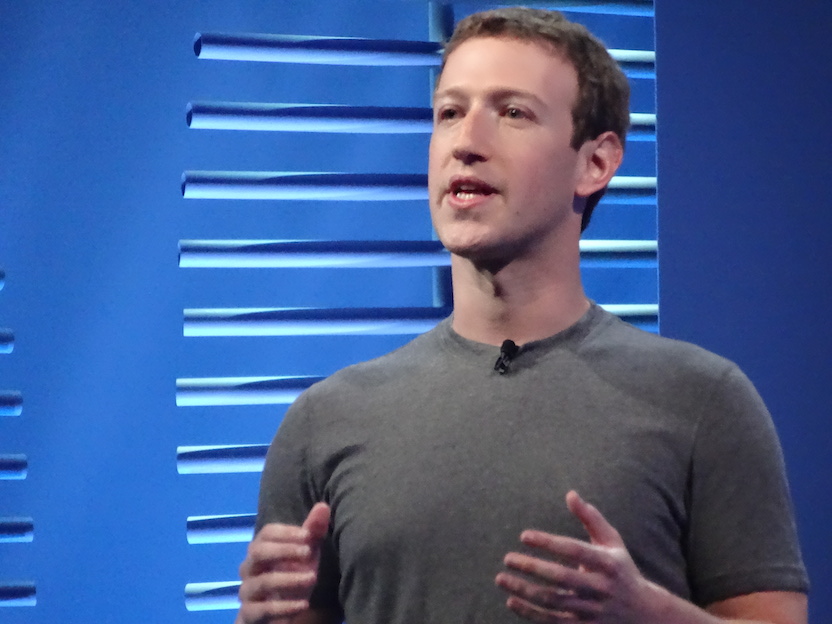 APPS
APPS
 APPS
APPS
 APPS
APPS
So much for that cautious outlook last quarter. Facebook Inc. today beat back its own executives’ muted forecasts with a 51 percent jump in fourth-quarter revenues.
The social network said revenues hit $8.8 billion, easily beating Wall Street analysts’ estimates of $8.5 billion. Profits more than doubled from a year ago, to $3.6 billion, or $1.21 a share. Excluding onetime costs, Facebook earned $1.41 a share, well over analysts’ $1.31 forecast.
Investors initially sent the shares, already up more than 2 percent in regular trading Wednesday to a record-high $133.23 a share, up again by more than 2 percent in after-hours trading. But later, after the earnings call, during which executives said they’d be spending a lot on new initiatives and reiterated the likelihood of slowing ad revenue growth, the shares were up well under 1 percent.
“Guidance on expense growth and capital expenditures for next year was higher than we previously forecast,” Pivotal Research Inc. analyst Brian Wieser said in a note to clients. He downgraded his rating on Facebook from a buy to a hold.
Investors appeared to brush off some bad news: Facebook lost a lawsuit that claimed Oculus executives used technology from game company ZeniMax Media Inc., and has been ordered to pay $500 million. It said it will appeal the ruling. Facebook bought Oculus for more than $2 billion in 2014.
Mobile ad revenues rose 61 percent to comprise 84 percent of company’s total ad revenues of $8.6 billion, up from 80 percent a year ago and steady with the third quarter. Facebook’s continued growth leaves the company in nearly an advertising duopoly with Google Inc. Last week, Google parent Alphabet Inc. reported better-than-expected fourth-quarter sales, and while a profit shortfall disappointed investors initially, analysts said Google’s own mobile and video ad growth is accelerating.
The reason for Facebook’s continued success is pretty simple, Forrester Research Inc. analyst Melissa Parrish said in an interview: “Advertisers want eyeballs and Facebook is where they are.”
![]() The results appeared to beat back investor concerns last quarter when Chief Financial David Wehner told investors during the third-quarter earnings call that there would be a “meaningful” slowdown in revenue growth thanks to “aggressive” investment in new areas this year as well as a lower ad load on pages that Facebook had instituted several quarter back. That knocked the stock down 9 percent in the hours immediately after the report.
The results appeared to beat back investor concerns last quarter when Chief Financial David Wehner told investors during the third-quarter earnings call that there would be a “meaningful” slowdown in revenue growth thanks to “aggressive” investment in new areas this year as well as a lower ad load on pages that Facebook had instituted several quarter back. That knocked the stock down 9 percent in the hours immediately after the report.
On the earnings call, Wehner said he continues to expect further slowing of revenue growth, leaving the revenue outlook unchanged from the previous quarter.
Facebook didn’t offer much color ahead of an earnings conference call scheduled for 2 p.m. Pacific. But it’s likely that video ads played a role in the surprise upside as well as mobile ads.
Facebook has been pushing into video on a number of fronts. Most recently, it is looking at creating a video app for television set-top boxes such as Apple TV, according to The Wall Street Journal. In January, the company said it will offer mid-roll video ads that allow publishers to insert ads into videos after they’re watched for more than 20 seconds, according to Recode. That’s in addition to Facebook’s live video charge for the past year.
The big advantage of video ads is that they could attract advertisers from television, still the largest single ad medium. Facebook founder and Chief Executive Mark Zuckerberg said on the conference call that Facebook plans to spend more on original video creators this year. But it still hasn’t taken a lot of advertising from TV yet.
“If they make good on licensing exclusive TV-like content, then they’ve got a shot at that giant bucket of TV money,” said Forrester’s Parrish. “But it will take those products [such as the video app] and consumer adoption of those products for it to be a reality.”
Despite ongoing concerns that Facebook could be losing ground to newer rivals such as Snapchat, people keep coming. It reported 1.23 billion daily active users, up 18 percent from a year ago. It also said it had 1.15 billion daily users on mobile.
Capital spending continues to grow quickly, from $692 million a year ago to $1.3 billion in the fourth quarter. Wehner said this will continue to be an “aggressive investment year,” with expenses likely to rise by 40 percent to 50 percent and hiring to grow more than last year’s 34 percent growth rate.
Zuckerberg also signaled that Facebook would continue to spend on new initiatives such as artificial intelligence and Internet connectivity. “We’re going to continue to invest in higher growth,” he said.
THANK YOU